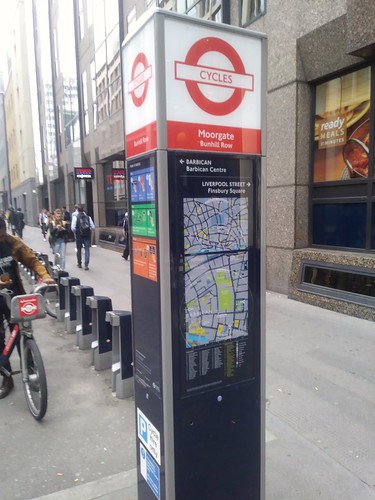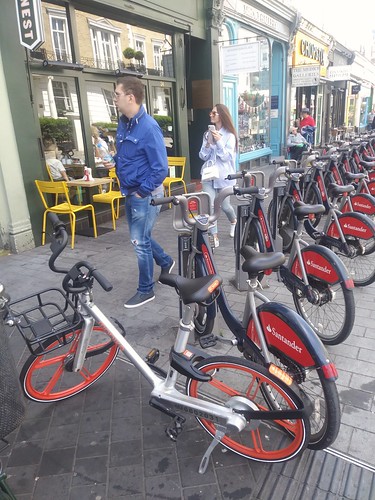Update: Bike sharing data from Seattle
=========
Update and a reposting of this entry with a new date:
NotionsCapital calls to our attention a DC-area workshop on dockless bike sharing, held in late May by the area MPO, featuring presentations by DC and Montgomery County, sharing their experiences with other jurisdictions. The presentations are online. See "Dockless bikeshare workshop emphasizes the importance of regional coordination," Transportation Policy Board, Bicycle and Pedestrian Subcommittee, Metropolitan Washington Council of Governments.
======
Dockless bikes in Seattle. Streetsblog photo.
In the same line of inquiry around my point that "The problem when you define every outcome as a success, you don't learn, and therefore failure is more likely: bike share in Seattle and Los Angeles as examples," comes data on dockless bike sharing in Seattle, "State of bike share: 10K bikes in Seattle — out of 44K nationwide — and 468K rides, study finds," as reported by Geekwire.
According to the data/interviews, most of the trips were utilitarian, that is for transportation, not recreation. From the article:
The study underscores the rapid growth of bike sharing in Seattle and the city’s status of a nationwide proving ground for the concept. The program only kicked off last summer, when the city granted permits to Spin and LimeBike starting with 500 bikes a piece, a threshold that was increased later in the year. In August, Chinese bike share company Ofo jumped into the fray.Although in my observation in DC, I believe most of the dockless bike trips are recreational, not transportational.
Nationwide, the survey found there were 44,000 dockless bikes in 25 cities at the end of last year, managed by five companies. Seattle’s approach has drawn national attention, and the study was undertaken earlier this year to find out information about who uses bike share, how they use it, and what they don’t like about the services.
The survey found that most people using bike share are biking to transit or work directly, with very few using the bikes for exercise. Most users were between the ages of 25 and 44 and 62 percent of users were male, according to the survey.
The survey found that 74 percent of respondents had a favorable opinion of the program, however 85 percent of comments received via phone and email were negative. The biggest complaints concerned poorly parked bikes, that the companies weren’t responsive and riders didn’t wear helmets.
About a third of residents have tried the program, another third hasn’t tried it but is open to doing so and the final third is unwilling to give bike share a shot.
If 10,000 bikes were used 468,000 times over a period of 7 months (210 days) that's 0.22 rides/bike/day. We know that figure isn't accurate because they didn't start out with 10,000 bikes. According to a more detailed assessment, "Taking stock of dockless bike share in Seattle," in Streetsblog, we know the actual number was 0.85 rides per day.
I don't see how that can be touted as a success.
The big advantage of dockless is that cities don't have to pay for the bikes, and can even make a little money from licensing ("D.C. withdraws plan targeting dockless bike operations with fees and parking demands," Washington Post), although it comes at a cost in terms of how the bikes are often discarded improperly in the public space.
Anyway, my issue with bike share in general is that in many respects, the issue of availability or access to bikes isn't what's holding people back from biking, as data in the National Household Travel Study indicates on average each household has at least one bike.
It's that in a paradigm of automobile-centric mobility, people need direct assistance to make the switch from the car to a bike for at least some of their trips.
 What's interesting about the traditional bike sharing system in London is how it is branded with a "roundel" from the same family of logotypes used to brand different forms of transit in London. The maps on the stations are drawn from the Legible London wayfinding system, rather than being a completely different system.
What's interesting about the traditional bike sharing system in London is how it is branded with a "roundel" from the same family of logotypes used to brand different forms of transit in London. The maps on the stations are drawn from the Legible London wayfinding system, rather than being a completely different system.My trip in the UK was a blur. I wanted to check out bike parking at train stations in a directed way. I didn't have the time.
I wanted to check out the bike hub at Heathrow Airport -- but I presumed I could get there but it turns out it is an employee only area and I would have had to set up a visit ahead of time with the Heathrow public communications group.
I wanted to check out London Cyclist Campaign and at least one of the biking assistance programs in cities and boroughs, and I didn't get to do it.
Many communities in the UK have programs that will lend or rent for a very low price a bike + helmet + lock for two to four weeks, to provide people with a way to try out biking, without their having to buy a bike and gear first, before being able to try it out. Many community centers in the UK offer bicycle skills training for free. And nationally, there is a program where people can buy bikes through a payroll deduction program. Some cities, including London, have programs that provide grants towards buying bikes.
-- Bikeability skills training, Hounslow, UK
-- "Hackney Cycle Loan Scheme: Borrow bike for month for just £10," Hackney borough, London
-- Cyclescheme | The UK's most popular cycle to work benefit
-- "Paris to offer subsidies to those who buy bikes, give up cars," Smart City Dive
Plus many communities have a wide range of cycle (and walking) promotion efforts, and there are national efforts too, like Let's Ride which bring "Open Streets" programs to cities across the country each year.
In general, such assistance programs are not offered in the US. Or at least they are not very prominent.
Some credit unions do provide loans to purchase bikes. Many bike advocacy groups offer skills training, although not usually for free. Most places do not have formal "bike lending" programs. At least, I haven't come across any examples in the US that are comparable to those in the UK.
 Santander bike share station near the South Kensington London Underground station, with a dockless bike. The placement of the docks at this station is interesting. While in the US and Canada Bixi type stations are placed at a 90 degree angle, this are placed at a 45 degree angle, to fit better from an urban design standpoint into the street and right of way.
Santander bike share station near the South Kensington London Underground station, with a dockless bike. The placement of the docks at this station is interesting. While in the US and Canada Bixi type stations are placed at a 90 degree angle, this are placed at a 45 degree angle, to fit better from an urban design standpoint into the street and right of way.Note that in talking about mobility in London with Ivan Bennett, formerly a senior product designer at Transport for London and now a consultant, he said the primary motivation for London introducing bike share wasn't to make money from it, but to increase the visibility of cycling as a way to encourage more people to cycle.
Given the very crowded public realm there, even though there is a fair amount of bike parking -- the UK seems to have stronger zoning and building requirements for the provision of bike parking at transit stations, office buildings, and housing estates, he doesn't believe they have the ability to accommodate dockless bike sharing in a way where improperly parked bikes won't cause problems.
In short, we need to put a lot more energy in developing direct assistance programs to help people make the shift from driving to biking for at least a preponderant number of trips.
More bikes a la bike share and more facilities a la bike lanes and even cycle tracks, do get more people biking, but given the research that finds that upwards of 2/3 of the US population is willing to bike for transportation and the current rates of less than 6%, clearly more focus needs to be put into programming
Labels: behavior change, bicycle and pedestrian planning, change-innovation-transformation, social marketing, sustainable mobility platform, urban design/placemaking




0 Comments:
Post a Comment
<< Home